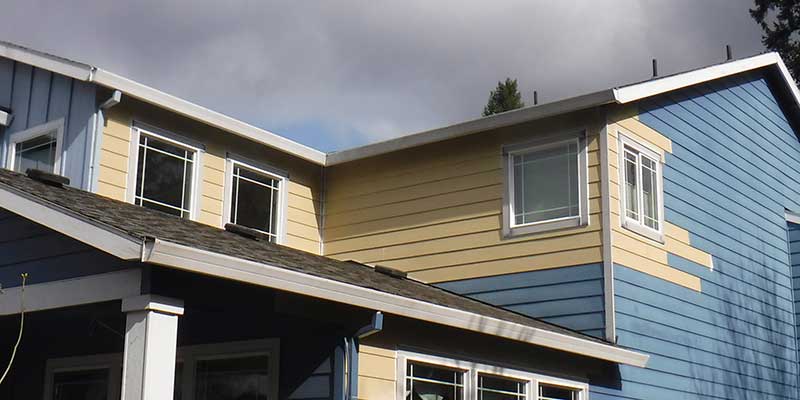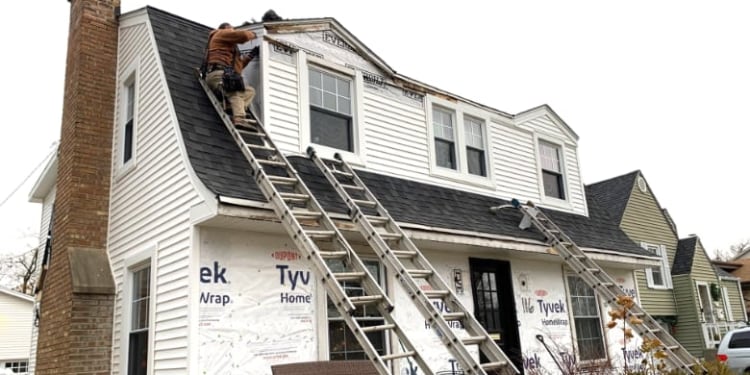The Essential Guide to the Various Kinds Of Exterior Siding and Their One-of-a-kind Benefits
In the world of home renovation, picking the appropriate house siding is an important choice that affects both aesthetic charm and practical performance. With so many options to think about, which exterior siding material truly stands out for your specific task?
Timber Exterior Siding
Timber exterior siding, a popular selection for domestic outsides, supplies an ageless visual that integrates natural beauty with architectural honesty. This home siding material is available in numerous designs, including clapboard, shingles, and board-and-batten, allowing home owners to personalize their façade to match their style choices. Timber siding is usually crafted from durable types such as cedar, redwood, or want, which are understood for their durability and capacity to stand up to environmental stressors.
One of the main benefits of timber home siding is its outstanding insulation residential properties, which can add to energy performance and lower home heating costs. In addition, timber house siding is biodegradable, making it an eco-friendly alternative when sourced sustainably. Routine maintenance, consisting of paint or discoloration, can extend its life-span and enhance its appearance, allowing house owners to preserve the natural beauty of the wood.
Nevertheless, prospective drawbacks consist of vulnerability to parasites, rot, and weather condition damage, demanding adequate treatment and upkeep - morris siding contractor. Despite these issues, when effectively cared for, wood siding can provide a lovely and sturdy option that enhances the character of a home while using a cozy, welcoming atmosphere

Vinyl Siding
Plastic exterior siding has actually become a leading selection for house owners seeking a low-maintenance outside option that incorporates toughness and affordability. This flexible product is crafted from polyvinyl chloride (PVC), making it resistant to numerous weather condition conditions, including dampness and UV rays. Consequently, vinyl siding does not warp, rot, or discolor, ensuring resilient aesthetic charm.
Among the primary advantages of vinyl house siding is its comprehensive array of styles and shades, allowing home owners to achieve the preferred search for their building without the requirement for frequent repainting. Furthermore, plastic siding is simple to mount, which can considerably decrease labor costs throughout building and construction or remodelling jobs.
Plastic siding also adds to power efficiency. Numerous choices attribute insulation support, which boosts thermal performance, assisting to keep comfy indoor temperature levels and potentially decreasing power bills. Moreover, its smooth surface area facilitates easy cleaning, needing only periodic cleaning with a yard tube to remove dirt and particles.
Fiber Concrete Home Siding
Fiber concrete siding has gotten grip among house owners and building contractors alike as a result of its exceptional mix of toughness and aesthetic flexibility. Composed of a mixture of sand, cellulose, and concrete fibers, this house siding choice is engineered to endure severe climate condition, including high winds, hefty rainfall, and temperature changes, making it a lasting choice for household exteriors.

One of the key benefits of fiber concrete home siding is its resistance to pests, such as termites, and its non-combustible nature, offering boosted fire safety. morris siding contractor. In addition, it is available in a large range of textures, shades, and styles, permitting homeowners to accomplish their wanted aesthetic without compromising efficiency
One more benefit is its low maintenance demands; fiber concrete siding normally calls for painting or discoloration every 5-10 years, which is much less frequent than other materials. Its long life adds to a reduced overall cost of ownership, as it minimizes the requirement for constant repairs or replacements.
Eventually, fiber cement home siding stands for a superb financial investment for those looking for a durable, attractive, and flexible outside option, combining both kind and function to improve the home's aesthetic appeal.
Steel Siding
The allure of steel siding lies in its durable resilience and modern aesthetic appeal, making it a favored option for contemporary design. Available in materials such as light weight aluminum and steel, steel house siding uses a range of surfaces and shades, enabling house owners to accomplish an individualized appearance that enhances their style vision.

Power efficiency is one more substantial benefit, as several steel house siding items are made with insulation alternatives that aid control Find Out More interior temperature levels. This can bring about lowered power prices with time. In addition, steel house siding is often recyclable, making it an environmentally friendly selection for sustainability-minded home owners.
The installment procedure for metal siding can be relatively uncomplicated, causing a quicker turn-around time for building jobs. In general, metal house siding combines functionality and design, making it a functional choice for those seeking a visually attractive and enduring outside surface.
Brick and Rock Home Siding
Brick and rock house siding stands apart as an ageless selection that enhances the visual appeal of any kind of home. Recognized for their sturdiness and low upkeep, these materials give a phenomenal return on financial investment while boosting the residential or commercial property's visual charm. Readily available in numerous colors, appearances, and patterns, block and stone can be customized to match diverse building designs, from typical to contemporary.
Among the key advantages of block and rock exterior siding is their power efficiency. Both materials possess natural protecting homes that help control interior temperatures, possibly minimizing heating and air conditioning expenses. Furthermore, they supply exceptional fire resistance contrasted to various other house siding choices, adding to boosted safety and security.
One more benefit is their longevity. Block and stone can last for decades, often calling for marginal upkeep beyond occasional cleaning. Unlike timber siding, click for more info they are unsusceptible insects and rot, making sure a durable exterior that stands up to the aspects.
Conclusion
In summary, the option of siding significantly impacts a home's aesthetic allure, power performance, and maintenance needs. Each kind of exterior siding-- whether wood, vinyl, fiber cement, metal, or block and stone-- provides one-of-a-kind advantages tailored to various home owner choices and environmental problems. Understanding these alternatives allows educated decisions that improve both the durability and aesthetic charm of residential exteriors. Eventually, choosing the right home siding is necessary for accomplishing an equilibrium in between performance and design in household architecture.
One of the key benefits of wood exterior siding is its outstanding insulation residential properties, which can add to energy efficiency and lower heating costs. Furthermore, timber exterior siding is naturally degradable, making it an ecologically pleasant alternative when sourced sustainably.One of the key benefits of steel siding is its resistance to various ecological variables.Power performance is an additional considerable advantage, as lots of steel exterior siding items are created with insulation options that help manage indoor temperature levels. Each kind of exterior siding-- whether wood, plastic, fiber steel, cement, or brick and rock-- offers one-of-a-kind advantages tailored to various property owner choices and ecological conditions.